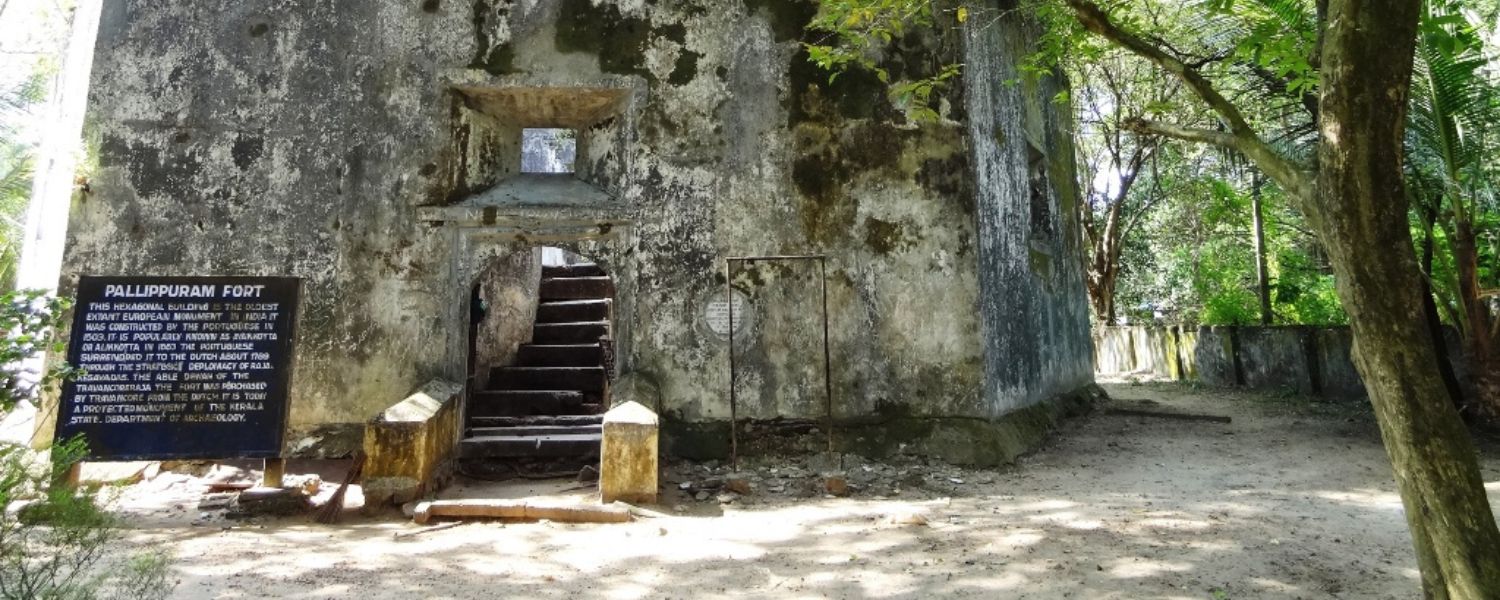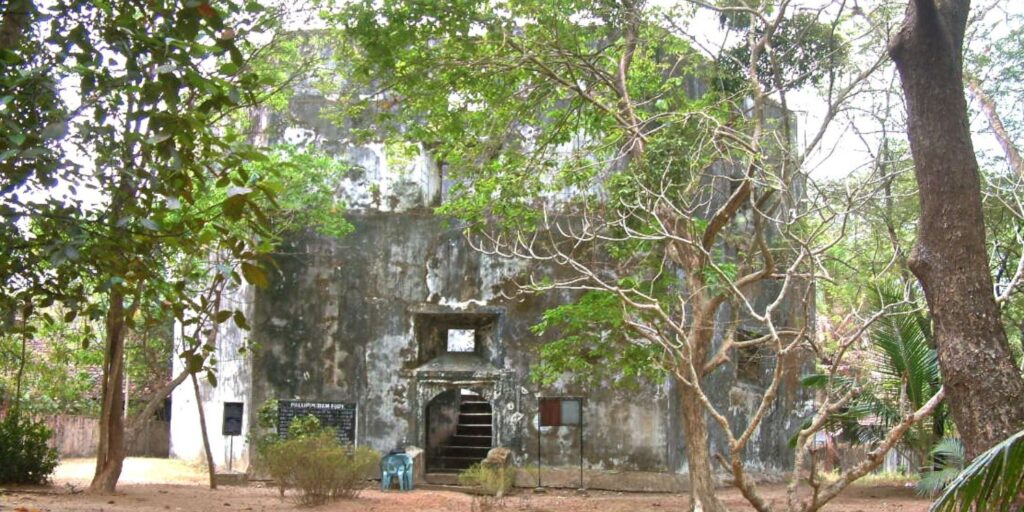Welcome to the illustrious Pallipuram Fort, a cherished relic in the serene village of Pallippuram, Vyppin, Kerala.
This historic bastion, erected on September 27, 1503 by Portuguese sailors, stands proudly as India’s oldest surviving European monument. However, originally crafted from timber, its formidable structure was later reinforced with stone in 1505, solidifying its place in Pallipuram fort history.
Perched majestically at the northern extremity of Vypin Island in the Ernakulam district, the Pallipuram Fort boasts architectural grandeur and a strategic significance that has endured the test of time.
Additionally, through the ebb and flow of history, this bastion witnessed the shifts of power, falling under Dutch dominion in 1661 before finding itself under the stewardship of the Kingdom of Travancore in 1789.
1. Story Behind the Name of Pallipuram Fort

However, the story behind Pallipuram Fort’s name is as fascinating as the fort itself. The fort is situated adjacent to the Manjumatha Church and borrows its name from this historic edifice.
Further, the Manjumatha Church, dedicated to the Lady of Snow, was constructed by the Portuguese contemporaneously with the Pallipuram Fort. The term “Pallippuram” is derived from the Malayalam word “Palli,” which means church. Hence, the environs surrounding the church became known as Pallippuram, consequently lending its name to the fort.
Adding to the intrigue is a captivating myth linked to the church’s name. During Tipu Sultan’s assault on Kochi, an extraordinary mist descended as he aimed to obliterate the church. This mystical mist enveloped the church, veiling it from Tipu Sultan’s sight.
This narrative not only underscores the historical significance of Pallipuram Fort but also adds a layer of mysticism to its name, echoing through the annals of time and exploring famous cities in Kerala.
2. History of Pallipuram Fort

The illustrious history of Pallipuram Fort, formerly known as Pallippuram Fort, stands as a testament to its strategic significance throughout the colonial era. Initially utilized by the Portuguese as a crucial base to oversee the movement of their ships navigating between the Periyar and the Arabian Sea, the fort boasted a cellar designed to store gunpowder. Adjacent to the fort, one could find essential structures such as living quarters, a church, and a hospital.
Additionally, through time, the fort faced turbulent episodes, notably the Dutch invasion in 1662, leading to their occupation of the stronghold. The fort’s pivotal location drew interest from various rulers, including the Mysore monarchs, who attempted to secure it from the Dutch.
However, the intervention of the East India Company thwarted their efforts. Ultimately, in a strategic maneuver, the ruler of Travancore acquired Pallipuram Fort in 1789, along with Kottappuram Fort.
Subsequently, with the decline of Mysore’s influence, the English East India Company extended its dominion over the Malabar region, relegating the fort’s importance over time.
Eventually abandoned by the military, the fort was recognized in a memorial erected by the Government of Travancore in 1909.
In a pivotal turn, in 1964, Pallipuram Fort gained protected status as a designated monument under the Department of Archaeology, ensuring its preservation for future generations to admire and reflect upon its storied past. Explore beaches in Kerala beach, no waves.
3. Structure and Architecture of Pallipuram Fort

However, situated majestically along the serene coastline, the Pallipuram Fort is a testament to Kerala’s rich historical legacy. The structure’s intricate architecture never fails to captivate visitors, with its hexagonal outpost, locally known as the ‘ayikkotta’ or ‘alikotta’.
The fort exudes a timeless charm, transitioning seamlessly from its raised lowest floor, standing five feet above the ground, to its finely dressed arched doorways, lintels, and gates.
A small flight of steps ushers visitors to the ground level while a northern opening unveils the cellar, steeped in intriguing history. This underground space once functioned as a repository for gunpowder and is believed to hide a clandestine tunnel leading to the nearby Cheraman Masjid in Kodungallur.
Crafted from a blend of laterite, chunam, and wood, the fort’s six walls, thickly plastered with mortar, are a testament to the skilled craftsmanship of yesteryears. Granite forms the foundation of the central circular slab door, standing as a sturdy sentinel against Pallipuram fort timings relentless march.
Despite the encroaching embrace of nature, with vegetation now adorning its weathered walls, the Pallipuram Fort remains an enduring symbol of Kerala’s architectural grandeur and historical intrigue.
4. How To Reach

Situated near the coastal marvels of Kochi, reaching Pallipuram Fort is a seamless experience. Transitioning smoothly from the bustling railways, visitors can alight at the Ernakulam Junction, a kilometer away from the primary boat jetty leading to Vypeen Island.
For air travelers, the Cochin International Airport is the gateway, approximately 20 kilometers from Ernakulam town to Vypeen Island. Once in Kochi, opt for a tranquil voyage via jetty services departing from Ernakulam and Kochi, bound for Vypeen.
Alternatively, bus services connecting Vypeen to Pallipuram offer an affordable and scenic route, ensuring every traveler can embark on a journey to uncover the rich heritage of Pallipuram Fort.
Conclusion
In conclusion, Pallipuram Fort is a shining emblem of Kerala’s rich historical tapestry, bearing witness to centuries of colonial intrigue and strategic importance. Its storied past, from its genesis in 1503 by Portuguese sailors to its subsequent transitions under Dutch and Travancore rule, echoes through its sturdy walls and intricate architecture.
Today, nestled along the serene coastline of Vypeen Island, this venerable bastion, also known as Ayikotta or Alikotta, beckons travelers to immerse themselves in its captivating allure.
Preserved as a designated monument since 1964, Pallipuram Fort inspires awe and admiration, inviting visitors to delve into Kerala’s colonial heritage and unravel the mysteries hidden within its weathered ramparts.
For those seeking to explore the annals of history, Pallipuram Fort is an unmissable destination, a testament to resilience and endurance amidst the sands of time.
FAQ
Q. What is the other name of Pallipuram Fort?
A. Pallipuram Fort, constructed in 1503 by the Portuguese, is also known as Ayikotta or Alikotta. This colossal hexagonal structure is a testament to the early European presence in India.
Q. What is Pallippuram famous for?
A. Pallipuram Fort, situated on Vypeen Island, earns renown as one of India’s oldest surviving European forts. Constructed with lime, laterite, and wood, it preserves a rich European heritage and is an iconic city landmark.
Q. Which was the first European fort in India?
A. The first European fort in India was Fort Emmanuel, established in 1503 by the Portuguese. Located in Fort Kochi, it symbolized the alliance between the ruler of Kochi and the Portuguese monarch.
Q. Which is the first fort in Kerala?
A. Pallipuram Fort, the manual fort built by in 1503, is Kerala’s oldest surviving European fort. Its hexagonal shape and historical significance make it a protected site, showcasing the region’s rich colonial past.










